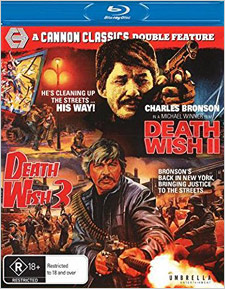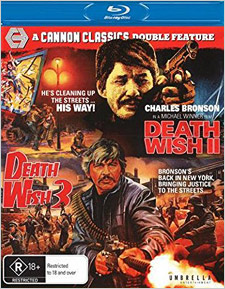Death Wish II/Death Wish 3: Cannon Classics Double Feature (Blu-ray Review)

Director
Michael WinnerRelease Date(s)
1982/1985 (August 2, 2017)Studio(s)
Golan-Globus Productions/Filmways Pictures/Cannon/MGM (Umbrella Entertainment)- Film/Program Grade: See Below
- Video Grade: See Below
- Audio Grade: See Below
- Extras Grade: B
- Overall Grade: B
Review
[Editor’s Note: This is an Australian REGION FREE Blu-ray release.]
The original Death Wish was an unexpected hit in 1974, which came with it a bit of controversy tied to it due to the amount of sexual violence in it, as well as its portrayal of vigilantism in a favorable light. However, it only helped the film at the box office as it resonated with audiences who were feeling increasingly antagonistic towards the hostility around them and the police who they were beginning to distrust. The film also caused a major shift in Charles Bronson’s career, which ultimately lead to him not being able to shed his Paul Kersey persona, even in other films. With great reluctance, he and Michael Winner eventually reteamed for Death Wish II and Death Wish 3 through Cannon Films in 1982 and 1985 respectively.
After the events of the first film, in which New York citizen and architect Paul Kersey seeks gun-toting vengeance against the hoodlums who raped his wife and daughter and managed to get away with it in the process, Kersey relocates to Los Angeles to start his life over in Death Wish II. Sporting a new girlfriend on his arm and his recently-released from therapy daughter on the other, it isn’t long before history repeats itself and a group of thugs not only rape and kill his housekeeper, but also kidnap his daughter, leading to her eventual demise. Kersey hits the streets again to find them and kill them all, meanwhile trying to avoid the police in the process. In Death Wish 3, he returns to New York, only to find that it has transformed into a rotting cesspool due to gang violence. Now known as a seasoned pro when it comes to being a vigilante, Kersey is unofficially hired by the police to go after the local criminals with his own brand of justice.
The Death Wish films have always operated on sort of a primordial level. While I personally believe they’re mostly mean-spirited in nature (which is due in no small part to the director, who seemed to have a misogynistic streak to him), they’re vicarious ventures that can result in disgust to some viewers. On the other hand, there’s something cathartic about watching someone go after those who have wronged them in such a brutal way. It’s part and parcel as to why there were no less than five films in the series, many imitators, and a remake of the original. Death Wish II was one of Michael Winner’s most controversial films due to the excessive rape scenes, but it wasn’t totally lost on the public who seemed to have an appetite for watching Bronson continue to clean up the streets. Death Wish 3, by comparison, went for a more outlandish and unbelievable approach, but is considered by many to be the most unintentionally hilarious entry in the series.
As far as Umbrella Entertainment’s transfers of each film, they seem to be sourced from previous masters, as evidenced by Shout! Factory’s release of Death Wish II. Judging them side by side, they appear to be the same. The elements utilized are in fine condition with decent grain management from scene to scene and strong detail on display. The color palette isn’t all that vibrant, but again, it’s due to the grittiness of the films themselves. While colors don’t really pop, skin tones are fairly natural. Black levels have some depth to them while overall brightness and contrast levels are acceptable. Shadow detail is sometimes lacking, but it’s also inherent in the original cinematography. No immediate signs of digital enhancements are present, however, minor damage is leftover, including mild speckling and telecine wobble. Death Wish II is also slightly less detail-oriented than Shout! Factory’s release, but only by a hair. The audio is presented as an English 2.0 Dolby Digital presentation (the Shout! release features an English mono DTS-HD track). Dialogue comes through clearly and audibly, while Jimmy Page’s over the top synth rock score has plenty of life to it. Sound effects do sound a little chunky and dated at times, but are well-rendered. Good tracks overall, despite being lossy. Subtitles are also provided in English if needed.
DEATH WISH II (FILM/VIDEO/AUDIO): B-/B/B-
DEATH WISH 3 (FILM/VIDEO/AUDIO): C+/B/B-
For the extras, Umbrella Entertainment’s release carries the best overall package. On Disc One, there are theatrical trailers for both films; 2 TV spots for Death Wish II (including a partial one); a TV spot for Death Wish 3; the vintage featurette Action II: The Making of Death Wish 3, Runaway Train, and House; and a set of Mark Hartley-directed interview outtakes from the Electric Boogaloo documentary, including screenwriter David Engelbach, actress Robin Sherwood, producer Bobby Roberts’ son Todd Roberts, and actor Alex Winter. There’s also an Easter egg if you highlight the trailer for Death Wish 3 and click left, a VHS of the film appears. If you click on that, you’ll be taken to a set of extended and deleted scenes from the film, which are sourced from an Australian VHS that is rumored to have been a potential TV edit of the film that somehow found its way onto the rental market. On Disc Two, which is a DVD, you get additional standard definition presentations of Death Wish II, including the theatrical version, the Greek VHS version, and the TV version. Text from Bronson biographer and author Paul Talbot opens each version, informing us of the various edits. The theatrical version is three minutes shorter than the unrated version, cutting the rape scenes in half, as well as Carol Kersey’s demise. The Greek VHS version is three minutes longer than the unrated version as it was sourced from an early workprint. It also contains additional dialogue scenes that were ultimately edited out. The TV version, obviously, removes and censors most of the sexual and violent material. It actually runs a few minutes longer than the theatrical version, but makes up for it with additional scenes. This version is also equipped with subtitles and chapter points to identify the alternate footage.
By comparison, the Shout! Factory Blu-ray release of Death Wish II contains both the theatrical and unrated versions in HD, the aforementioned English mono DTS-HD track, an audio commentary with Paul Tabot, and an animated still gallery. Currently, the only U.S. Blu-ray of Death Wish 3 is pretty spare on extras, but it does feature the original English audio in mono DTS-HD. All in all, this is a great double feature package from Umbrella Entertainment, especially for long-time fans of the series. The extra material makes Death Wish II in particularly all the more intense and brutal, but having it preserved is a good thing. While it has its pros and cons, it’s still a nice package.
-Tim Salmons

